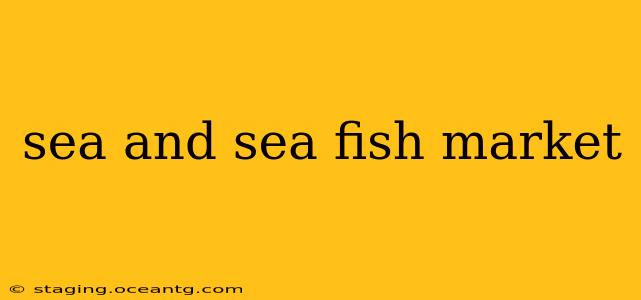The rhythmic crash of waves, the salty tang in the air, and the vibrant display of glistening seafood – a visit to a sea and seafood market is a sensory experience unlike any other. These bustling hubs connect the ocean's bounty directly to consumers, offering a unique opportunity to appreciate the diversity and freshness of marine life. This comprehensive guide explores the fascinating world of sea and seafood markets, covering everything from their historical significance to the best practices for selecting the freshest catches.
What is a Sea and Seafood Market?
A sea and seafood market, simply put, is a marketplace specializing in the sale of fish and other seafood harvested from the ocean or other bodies of saltwater. These markets vary widely in size and scale, from small, family-run operations on coastal towns to large, commercial establishments in major cities. The common thread is the direct connection between the fisherman or supplier and the consumer, often resulting in higher quality and fresher seafood than what's available in supermarkets.
What Types of Fish and Seafood Can You Find?
The types of fish and seafood available at a sea and seafood market depend heavily on location and seasonality. However, you can generally expect a wide variety, including:
- Popular choices: Salmon, tuna, cod, shrimp, lobster, crab, and scallops are frequently found.
- Regional specialties: Depending on the region, you might find unique species not commonly available elsewhere. For example, a market near the Mediterranean might offer a broader selection of Mediterranean species.
- Shellfish: A diverse range of oysters, clams, mussels, and other shellfish are often prominently displayed.
How to Choose the Freshest Seafood
Selecting the freshest seafood is crucial for both taste and safety. Here are some key indicators to look for:
- Smell: Fresh fish should have a mild, pleasant ocean scent. A strong, ammonia-like odor indicates spoilage.
- Eyes: In whole fish, the eyes should be clear and bright, not cloudy or sunken.
- Gills: The gills should be bright red or pink, not brown or gray.
- Texture: The flesh should be firm and elastic, not mushy or flabby. Gently press the fish; it should spring back.
- Scales (if applicable): Scales should be shiny and firmly attached.
What are the Benefits of Buying Seafood from a Market?
Shopping at a sea and seafood market offers several advantages over supermarkets:
- Freshness: The seafood is often caught and delivered very recently, resulting in superior flavor and texture.
- Sustainability: Many markets prioritize sourcing from sustainable fisheries, promoting responsible fishing practices.
- Variety: You're likely to find a much wider variety of species than in a typical grocery store.
- Direct Interaction: You can engage directly with vendors, learn about the sourcing of the seafood, and even get recommendations for cooking.
- Support Local Businesses: Buying from local markets supports the local economy and fishing communities.
What is the Difference Between a Sea Market and a Regular Fish Market?
While the terms are often used interchangeably, a "sea market" often implies a broader range of marine products beyond just fish. This could include seaweed, shellfish, and other ocean-sourced goods. A "fish market" more specifically focuses on various types of fish. The distinction is often subtle and dependent on local usage.
Are Sea and Seafood Markets Sustainable?
The sustainability of sea and seafood markets varies considerably. Some prioritize responsible sourcing from certified sustainable fisheries, while others may not. When choosing a market, consider asking about their sourcing practices and look for certifications like Marine Stewardship Council (MSC). Supporting sustainable markets is vital for the long-term health of our oceans.
How Much Does Seafood Cost at a Market?
Pricing varies greatly depending on the type of seafood, season, location, and market. Generally, expect prices to be somewhat higher than in supermarkets, reflecting the higher quality and freshness.
Conclusion
Sea and seafood markets offer a unique and rewarding experience for seafood lovers. By understanding how to choose the freshest seafood and supporting sustainable practices, you can fully appreciate the delicious bounty of the ocean. The next time you're near a coastal area, make it a point to visit a local market and savor the vibrant atmosphere and incredible tastes.
